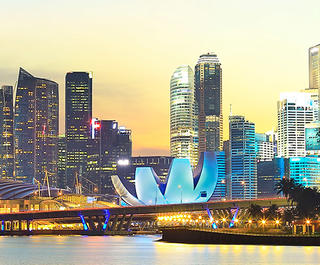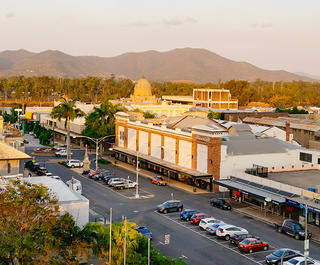
The origins of Florence are Roman, but it was during the Middle Ages and the Renaissance that the city flourished as one of Europe’s greatest and wealthiest settlements – its wealth based on silk and fabrics, and on a series of immensely rich banking dynasties.
And what those bankers and merchants liked to do best was to display that wealth as extravagantly as possible. They built churches, towers, palaces, bridges and offices and they were always attracted to the latest fashions and technologies.
Such generous partronage meant that, for several centuries, Florence became a magnet for many of the most ambitious architects and artists of the time.
 Florence: A picture of elegance
Florence: A picture of elegance
The city’s art galleries tell the story in their own compact and accessible way. But it is the buildings themselves – from the tall defensive towers which attest to the social turbulence behind Florence’s early wealth and creativity, to the delicate patterns and angles of the baptistery, the soaring dome of the cathedral, the crenellated tower of the Palazzo Vecchio and the shop-lined parapets of the Ponte Vecchio - that still comprise the city itself, and that really express the history of Florence.
Walking the streets of this compact city with your eyes open to these remarkable buildings is the best way to immerse yourself in that past. Here are a dozen you musn’t miss.
The Baptistery Of San Giovanni
Mainly 11th to 13th century
 The great and good were baptised here
The great and good were baptised here
Dedicated to Florence’s patron saint, the Baptistery is the heart of the city’s religious history; over the centuries, countless Florentines were baptised here, including Dante.
Its characteristic architectural style is splendid Tuscan Romanesque, clad entirely with white and green marble. Most of the present structure dates from a comprehensive modernisation in the 11th century.
The three famous portals (doors) were added in stages; the first, south, by Andrea Pisano, in 1330; the next, north, by Lorenzo Ghiberti, 1403; finally, the famous golden east doors, the Porta del Paradiso, also by Ghiberti, 1425 – the orignals are now in Duomo musem.
Its octagon plan has a great central space, designed to hold hundreds, and originally with a central font. The upper vaults are clad with magnificent mosaics, begun in 1225, and completed a century later.
The Palazzo Vecchio
First stage 1299-1314; (several later phases)
 Heart of the city's government
Heart of the city's government
The heart of the city’s government since the era of the medieval free commune. The original fortified core, more castle than palace, was later enlarged in stages by the Medici, who retained the Palazzo as their seat of power.
Cosimo I transformed the great Sala dei Cinquecento (Hall of the Five Hundred) from a place of democratic assembly into a throne-room, lavishly decorated by Giorgio Vasari.
He also extended the Palazzo, with private suites of rooms for his family and retinue, all richly decorated. Long after the demise of the Medici, the Palazzo retained political importance. The national parliament assembled here in 1865-70, and it still houses the city’s government today.
Santa Maria Del Fiore, The Duomo
1296-1421
 The cupola was added in the 1440s
The cupola was added in the 1440s
Florence’s cathedral, and one of the largest churches in the world. Begun by Arnolfo di Cambio, it was completed in the 1400s, when Brunelleschi added the magnificent cupola and its lantern.
The west facade was only added in the mid-19th century. The massive exterior is entirely clad with coloured marble; by contrast, the interior is simple and austere, almost devoid of decoration, other than the splendid stained glass windows.
Brunelleschi’s cupola, a remarkable feat of engineering, has become perhaps the most famous icon of the city, physically and metaphorically looming over Florence and its surrounding hills.
Orsanmichele
1337-1404
 Orsanmichele began life as a grain store
Orsanmichele began life as a grain store
This unique structure ('San Michele in Orto’) has a long, complex history. Originally built as a single-storey warehouse for grain and flour, it was later turned into a church, the base for the city’s numerous and powerful trade guilds.
The two upper floors were added after 1367, again as a grain store. The exterior was richly decorated with statues in niches around the four facades, representing the arti (guilds) with sculptures by Donatello, Ghiberti and others. The church contains a splendidly rich tabernacle by Orcagna (1359).
Want more on this city of beauty? The Most Beautiful Sights in Florence
It's on the list of romantic cities. The World’s Most Beautiful Locations That Inspire Romance
The Ponte Vecchio
1345
 The ancient bridge that says Florence
The ancient bridge that says Florence
The oldest surviving bridge in the city, rebuilt after a disastrous flood in 1333. The little shops that line it on both sides are supported on jetties over the river, and were intended to raise revenue for the bridge’s maintenance.
The bridge formed a vital link to the district of Oltrarno, across the river, and the road that led to Rome. In 1565 the Corridoio Vasariano was built on top, to provide a safe passage linking the Uffizi to the monumental Palazzo Pitti, across the Arno, the new home of the Medici court.
The Palazzo Degli Uffizi
1559-80
 The galleries house the famous Medici collection
The galleries house the famous Medici collection
The Uffizi have been called the world’s earliest purpose-designed office buildings. Begun by Giorgio Vasari, for duke Cosimo I, following his defeat of Siena, and the subsequent annexation of Sienese territories, doubling the size of the Florentine state.
Thirteen magistracies were accommodated here, in two long parallel wings, linked to each other at the south end, and with a bridge to the Palazzo Vecchio. On the top floor, a long series of galleries was built to house the Medici's remarkable collections of classical sculptures and paintings; these are the present Uffizi galleries, first opened to the public in 1591, and today one of the world’s finest art collections.
Piazza della Repubblica
1883-96
 The construction followed massive demolition
The construction followed massive demolition
Today the centre of city life, the Piazza was formed in the late 19th century, following massive demolitions in the historic centre, including the Ghetto and the Mercato Vecchio.
The Piazza is surrounded by typically self-confident 19th century palazzi, that on the west side, with the Arcone, being the most monumental. The inscription on the entablature, though, praising the 'bringing back to health’ to the city, became notorious, since it involved so much destruction of the historic centre.
Stazione Centrale di Santa Maria Novella
1933-5
 The station has a daring folded concrete roof
The station has a daring folded concrete roof
Florence’s main railway station is the finest 20th-century building in the city; designed by the Gruppo Toscano, whose members included the remarkable Giovanni Michelucci, following a competition.
The exterior is uncompromisingly modern, with a dramatic glazed entrance, inside which is the impressive ticket hall, clad with yellow marble. The main concourse, the Galleria di Testa, has no internal columns, and is covered with a daring folded concrete roof, with a great glazed north-light window.
Visit your local Flight Centre store or call 131 600 for more advice and the latest deals on travelling to Florence.
This article was from The Daily Telegraph and was legally licensed through the NewsCred publisher network.










